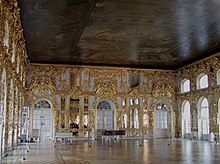Ballroom


A ballroom (from "ball" in the sense of dance ball ; from Italian ballo " dance "), also called redoubt and English ballroom , is an elegant, prestigious place where dance balls are held.
From the aristocratic to the bourgeois public
In contrast to the simple dance floor , the ballroom was in the 17th and 18th centuries. Century an aristocratic institution and part of castles . The redoubts , which became fashionable at the end of the 17th century, were intended for masked balls and the minuet as the main dance.
As long as no fixed rows of chairs were installed, the parquet of theaters could also be used as a ballroom - as is still the case today at the Vienna Opera Ball , for which the now fixed seating on the ground floor is being dismantled.
In the 19th century, numerous bourgeois ballrooms were built, financed by entrance fees. Many of these ballrooms were combined with restaurants . Mainly waltzes and other couple dances were danced there.
The large dance floor in ballrooms enables counter dances , i.e. dance- like parlor games between several couples such as the quadrille . Around the dance floor there were spectator seats, often boxes and booths as well . Diplomacy and the ballroom have been closely linked since the Congress of Vienna in 1814/1815 . The ballroom became the epitome of the "sophisticated".
Structural properties and current uses
Ballrooms had high ceilings and are therefore difficult to heat and expensive to maintain. Because the dance music was played live, ballrooms had to have suitable acoustics . A suitable parquet was also required for the elegant shoes of the dancers (see dance shoes ) . Specialized dance bands , which mainly consisted of string instruments and played under the direction of the primary violinist (like Johann Strauss (father) and Johann Strauss (son) ) throughout the night, provided the music . They were not yet as powerful as the marching bands of the 20th century and needed sufficient reverberation . The Allgemeine Musikalische Zeitung complained in 1870 that the hall of the Wiener Musikverein , which is now praised for its acoustics, was built more as a ballroom than a concert hall .
Some ballrooms such as the Vienna Sofiensäle were also used as swimming pools depending on the season . Since the social importance of the balls dwindled, so increasingly after the end of the First World War , most ballrooms have been converted or demolished. Few ballrooms are still used as nightclubs or discos like the Webster Hall in New York City , built in 1886 and now a listed building. Another famous example is the redouten halls of the Vienna Hofburg . They were built under Maria Theresa in the 18th century and are still used today as concert and event halls.
Numerous hotels (but also large passenger steamers ) that were built around 1900 had ballrooms. Many today are too big to be used in normal operation. The Vienna Chamber Opera is now located in the ballroom of the Hotel Post in Vienna , there is a cinema in the ballroom of the Hotel National in Bern , and the Bowery Ballroom in Manhattan is mainly used for concerts.
Often confused with the ballroom, the ballroom , like the famous ballroom in Versailles , where ball was played, is a pre-form of tennis called Jeu de Paume . Some of these ball houses were converted into theaters or dance halls after the ball game fashion subsided.
literature
- Johann Georg Krünitz u. a .: Oeconomische Encyclopädie , Berlin: Pauli 1821, Vol. 129, pp. 203f.
- Monika Fink: Redoute. In: Oesterreichisches Musiklexikon . Online edition, Vienna 2002 ff., ISBN 3-7001-3077-5 ; Print edition: Volume 4, Verlag der Österreichischen Akademie der Wissenschaften, Vienna 2005, ISBN 3-7001-3046-5 .
Individual evidence
- ↑ Allgemeine Musikalische Zeitung, No. 7, 1870, p. 54

